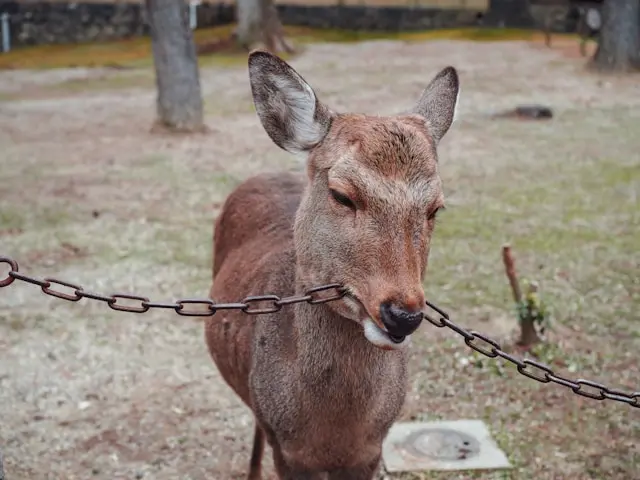
1. Where did Nara’s deer come from?
In 710 AD, when Nara became Japan’s capital (then called Heijo-kyo), a legend tells of the deity Takemikazuchi arriving at Kasuga Taisha Shrine on a white deer. From that ancient time, deer have been present in Nara, revered as divine messengers. Over 1,300 years of generations have passed, and today, some deer in Nara Park are said to have white patches on their hind legs. Locals believe these are descendants of the original sacred deer, and spotting one is considered lucky—though I’ve never seen one myself.
2. Are the deer in Nara Park wild?
Surprisingly, yes—the deer are wild. While the city works to protect them through organizations like the Nara Deer Preservation Foundation, and Kasuga Taisha maintains a Deer Shelter that cares for around 300 injured or pregnant deer, the rest roam freely. Pregnant deer are housed separately to avoid potentially dangerous interactions with visitors, as they can become easily agitated.
3. Do deer bite? Do they really bow?
Deer don’t exactly bite people. Instead, they use their mouths to nudge you for treats, particularly if you’re holding shika-senbei (deer crackers) but not offering them quickly enough. Their enthusiasm depends on the deer’s size, strength, and your ability to dodge. I once got a playful “headbutt” and still have a small mark as a memento!
As for the bowing, it’s not really a polite gesture. Deer naturally bow to each other as a form of display before a fight. So when a deer bows at you, it’s more like a demand: “Give me the cracker, or else!” If you want them to stop following you, hide the crackers, raise your hands, and show them you’re empty-handed—they’re smart enough to understand.
4. What are deer crackers made of?
The shika-senbei sold in Nara Park are 80% produced by Takeda Toshio Shoten, a company recognized by Kasuga Taisha. These crackers are made from unsweetened, unflavored rice bran and wheat flour, making them safe for the deer to eat. The company, now in its third generation, produces 30,000–50,000 crackers daily during the peak tourist seasons in spring and autumn.
Deer seem to prefer:
1. Shika-senbei (their favorite!)
2. Acorns
3. Grass
5. Other Fun Facts About Nara’s Deer
• No Trash Bins in Nara Park: To prevent deer from rummaging through garbage and accidentally consuming harmful waste, there are no trash bins in the park.
• Tree Protection: To stop deer from gnawing on tree bark, most trees in Nara Park have protective wire mesh around their trunks.
• “Deer Feeding Line”: The forest in Nara Park shows a distinct line at about 2 meters (the height deer can reach while standing on their hind legs to eat leaves). Below this line, all the leaves are gone, creating an even “feeding line” visible from a distance.
• Restroom Doors: Public toilets in the park feature extra doors to prevent deer from wandering in.
• Grass Adaptation: The grass in Nara Park is finer and shorter than usual, making it harder for deer to eat. This natural adaptation helps maintain the ecosystem, and as a bonus, the park doesn’t need to mow its 79-hectare lawn—saving approximately 10 billion yen in annual maintenance costs.
An American traveler once said that the harmony between Nara’s deer and its people deeply moved them, making Nara their favorite city. Sometimes, all it takes is one reason to fall in love with a place. Now that you’ve learned about the history and quirks of Nara’s deer, do you see them in a different light? Next time you meet these gentle creatures, perhaps you’ll appreciate them even more!
